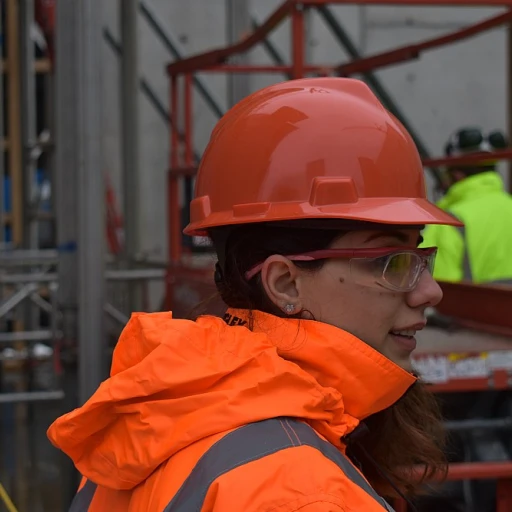Understanding Ageism: A Workplace Challenge
The Unseen Barrier: Ageism in Workplace Communication
Ageism is a significant challenge within workplace environments, often manifesting subtly in communication practices. It involves stereotypes and discriminatory actions based on one's age, affecting both older and younger employees. This bias can create an environment where age diversity is not valued, leading to negative consequences for both individuals and organizations. Ageism can emerge in various forms, such as younger workers dismissing the contributions of older employees or older individuals assuming that younger colleagues lack experience. These assumptions foster a workplace culture where age becomes a divisive factor rather than a strength. In many companies, older workers face implicit discrimination in communication. There may be an unconscious bias that they are less adaptable to technological changes or resistant to new ideas. Conversely, younger employees might be perceived as inexperienced or not serious enough. These perceptions can hinder effective collaboration and reduce productivity. Understanding and acknowledging age-based discrimination is the first step in addressing it. Employers and HR professionals must recognize that ageism is not just a personal injury to those discriminated against but also detrimental to the company’s growth and culture. By fostering an age-diverse workplace, businesses can enhance innovation and improve performance. For insights into how such practices can elevate organizational culture, exploring the benefits of employee recognition programs can be enlightening. When looking at examples of ageism in the workplace, it’s crucial to consider how communication often reinforces age biases. For instance, comments about being "too young for this role" or "too old to learn new tools" exemplify age-based assumptions that can lead to a toxic work environment. Organizations must strive to create communication practices that respect and value contributions from all employees, regardless of age.Subtle Signs of Ageism in Communication
The Covert Manifestations of Ageism in Workplace Communication
In the modern workplace, age discrimination often takes a subtle form, yet it has palpable effects on employees of all ages. The underlying biases can shape communication patterns in a way that marginalizes older workers while inadvertently favoring their younger counterparts. Let's explore some instances where ageism subtly infiltrates workplace interactions, posing challenges for both employees and employers. One of the tell-tale signs of ageism is the assumption that only younger employees can handle certain technologies or innovative strategies. Older workers may find themselves being bypassed for roles that involve digital skills, not because of a lack of capability, but because of preconceived notions about age and adaptability. This kind of discrimination based on age undermines the value that older employees bring to the team, such as experience, stability, and a rich professional history. Another example is the language used in job postings and communications. Phrases like "young, dynamic team" or "seeking fresh perspective" can discourage older adults from applying, as they implicitly suggest a preference for youth over experience. Such wording not only affects potential applicants but also signals to current employees that their age may be a barrier to progressing or even remaining within the company. Moreover, meetings and brainstorming sessions can be environments ripe for ageism, where the insights of older employees are often overshadowed or dismissed. Younger workers might unintentionally dominate these discussions, leading to a culture where only a spectrum of ideas from a particular age group get recognized. This not only hinders the diversification of perspectives but can also result in missed opportunities for innovative solutions. Performance reviews offer another opportunity for age-based bias. If not carefully conducted, these evaluations may reflect ageist presumptions about an employee's capacity or future in the company. Companies need to ensure that feedback is grounded in performance metrics, free from age discrimination. Finally, informal social interactions and workplace culture play a role. Jokes about age or assumptions about retirement can create a work environment where age discrimination is normalized. Such interactions, although seemingly trivial, can erode the morale of older workers and plant seeds of doubt about their relevance and effectiveness. Employers and HR professionals must remain vigilant against these subtle forms of ageism, ensuring that communication remains respectful and inclusive. Learn more about creating an inclusive workplace with our article on making recognition central to HR communication at our blog. Recognizing these challenges is the first step toward fostering a more age-inclusive workplace culture.Overt Examples of Ageism in the Workplace
Visible Forms of Age Discrimination in Professional Settings
Ageism in the workplace can manifest in various overt ways that negatively impact the morale of employees regardless of their age. Clear examples of age discrimination include denying older workers opportunities for advancement or training, simply because they are considered too old or nearing retirement. Such actions not only affect the career progression of older employees but also convey a message that their contributions are undervalued by the employer.
Conversely, younger employees may face discrimination in the form of being overlooked for certain positions, with the assumption that they lack the necessary experience or maturity. This bias can hinder their professional growth and contribute to a work environment that undervalues the potential of fresh perspectives.
For employers aiming to ensure legal and ethical compliance, understanding these examples of ageism within their company is crucial to preventing potential violations of employment law. Encouraging an open dialogue and instilling policies that promote age diversity can safeguard against age-based discrimination, allowing for a more inclusive and productive workplace.
Moreover, by recognizing such issues, pragmatic solutions can be introduced to support employees of all ages, thus enhancing the employee experience through effective HR communication and engagement.
Impact of Ageism on Employee Morale and Productivity
Recognizing Emotional and Operational Consequences
Ageism in workplace communication can severely impact employee morale and productivity. When older adults face discrimination based on age, it undermines their confidence, often leading to decreased job satisfaction. This is further exacerbated when older workers perceive that their contributions are undervalued compared to younger employees. The resulting demotivation can affect overall productivity, as these employees may not be as engaged in their work tasks.
The presence of ageism can also strain team dynamics. Discrimination workplace scenarios where younger workers are favored over older employees may sow discord and resentment, creating an unproductive and hostile work environment. This can hinder effective collaboration and communication, negatively affecting the company's bottom line.
Moreover, age-based discrimination has legal and reputational repercussions. Employers need to be aware that age discrimination employment laws protect employees age 40 and older from unfair practices. Violating these laws not only risks legal action but can also damage the company's reputation as an inclusive employer.
Understanding these impacts is crucial for employers committed to fostering a diverse and harmonious workplace. By acknowledging the detrimental effects of ageism, companies can take proactive steps in crafting HR communications that emphasize inclusivity and respect for all employees, regardless of age.
Strategies for Combating Ageism in HR Communication
Implementing Inclusive Communication Policies
Addressing ageism in workplace communication requires a proactive approach from human resources. Employers must ensure that their communication policies are inclusive and respectful of all age groups. By establishing clear guidelines that prohibit age-based discrimination, companies can foster a more equitable work environment. These policies should be regularly reviewed and updated to reflect current employment laws and best practices.
Training and Awareness Programs
One effective strategy to combat ageism is to implement training and awareness programs. These programs should educate employees about the subtle signs of ageism and its impact on morale and productivity. By raising awareness, companies can help younger and older workers understand the value of age diversity and encourage mutual respect. Training sessions can include real-life examples of ageism to illustrate its effects and reinforce the importance of inclusive communication.
Encouraging Intergenerational Collaboration
Promoting collaboration between younger employees and older workers can help break down age-related stereotypes. Employers can create opportunities for mentorship and knowledge-sharing, allowing employees of different ages to learn from each other. This not only enhances the skills of all employees but also strengthens the company's overall performance. Encouraging such interactions can transform age diversity into a significant organizational strength.
Regular Feedback and Open Communication
Establishing a culture of regular feedback and open communication is crucial in addressing ageism. Employers should encourage employees to voice concerns about age discrimination without fear of retaliation. Creating safe channels for communication allows companies to address issues promptly and effectively. Regular feedback sessions can also help identify any underlying biases and promote a more inclusive workplace culture.
Leadership Commitment to Age Diversity
Finally, leadership commitment is essential in combating ageism. Employers and company leaders must demonstrate a genuine commitment to age diversity by setting an example. This includes recognizing the contributions of older adults and younger employees alike, and ensuring that all workers feel valued and respected. Leadership should actively promote policies that support age diversity and hold themselves accountable for creating an inclusive workplace.
Promoting Age Diversity as a Strength
Embracing Age Diversity to Strengthen the Workplace
Companies that embrace age diversity not only foster inclusivity, but also benefit from a wealth of experience, perspectives, and innovation that can drive business success. The modern workplace is increasingly acknowledging the importance of age diversity as a critical component of a productive and harmonious work environment.
Age diversity allows an organization to tap into the diverse skill sets and experiences of its workforce. By valuing the contributions of both older workers and younger employees, businesses can create a dynamic team environment that stimulates creativity and problem-solving.
Promoting age diversity starts with recognizing and appreciating the unique strengths that different age groups bring to the workplace. This includes understanding that older workers often have a vast amount of industry knowledge and valuable insights based on years of experience, while younger employees may introduce fresh perspectives and familiarity with emerging technologies.
To effectively promote age diversity:
- Highlight Diversity in Recruitment: Employers should implement hiring practices that encourage a mix of different age groups, thus enriching the company culture and eliminating age-based discrimination in employment.
- Foster Intergenerational Collaboration: Encourage team-building activities and projects that require collaboration between employees of varying ages. This can help break down age barriers and promote mutual respect and understanding.
- Provide Equal Opportunities for Professional Development: Offer training and advancement programs available to all employees, regardless of age. Such practices demonstrate a commitment to lifelong learning and career growth for everyone.
- Shift Mindsets and Challenge Stereotypes: Create awareness and education programs that help shift mindsets towards recognizing the value of age diversity. It’s essential to challenge age bias and ageism examples that exist in the workplace.
By embracing age diversity as a strength, companies not only comply with employment laws against age discrimination but also enhance overall employee morale and productivity. Acknowledging, addressing, and actively promoting age diversity can transform a workplace into a vibrant, inclusive hub of innovation, talent, and mutual support.








